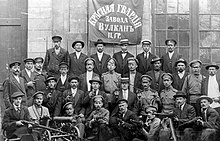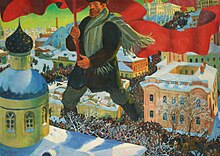
Back Winterfylleþes Oferþrāwende ANG الثورة البلشفية Arabic الثوره البلشفيه ARZ Revolución d'Ochobre de 1917 AST Oktyabr inqilabı Azerbaijani اوکتوبر اینقیلابی AZB Октябрь революцияһы Bashkir Кастрычніцкая рэвалюцыя Byelorussian Кастрычніцкі пераварот BE-X-OLD Октомврийска революция Bulgarian
| October Revolution | |||||||
|---|---|---|---|---|---|---|---|
| Part of the Russian Revolution, the Revolutions of 1917–1923 and the Russian Civil War | |||||||
 The Winter Palace of Petrograd, one day after the insurrection, 8 November | |||||||
| |||||||
| Belligerents | |||||||
|
|
| ||||||
| Commanders and leaders | |||||||
|
|
| ||||||
| Strength | |||||||
| |||||||
| Casualties and losses | |||||||
| Few wounded Red Guard soldiers[4] | All imprisoned or deserted | ||||||



The October Revolution,[a] also known as the Great October Socialist Revolution[b] (in Soviet historiography), October coup,[5][6] Bolshevik coup,[6] or Bolshevik revolution,[7][8] was a revolution in Russia led by the Bolshevik Party of Vladimir Lenin that was a key moment in the larger Russian Revolution of 1917–1923. It was the second revolutionary change of government in Russia in 1917. It took place through an insurrection in Petrograd (now Saint Petersburg) on 7 November 1917 [O.S. 25 October]. It was the precipitating event of the Russian Civil War. The initial stage of the October Revolution which involved the assault on Petrograd occurred largely without any human casualties.[9][10][11]
The October Revolution followed and capitalized on the February Revolution earlier that year, which had led to the abdication of Nicholas II and the creation of a provisional government. The provisional government, led by Alexander Kerensky, had taken power after Grand Duke Michael, the younger brother of Nicholas II, declined to take power. During this time, urban workers began to organize into councils (soviets) wherein revolutionaries criticized the provisional government and its actions. The provisional government remained unpopular, especially because it was continuing to fight in World War I, and had ruled with an iron fist throughout mid-1917 (including killing hundreds of protesters in the July Days). It declared Russia as a republic on 1 September (O.S.; 14 September, N.S.) 1917.
Events came to a head in late 1917 as the Directorate, led by the left-wing Party of Socialist-Revolutionaries (SRs), controlled the government. The far-left Bolsheviks were deeply unhappy with the government, and began spreading calls for a military uprising. On 10 October 1917 (O.S.; 23 October, N.S.), the Petrograd Soviet, led by Leon Trotsky, voted to back a military uprising. On 24 October (O.S.; 6 November, N.S.), the government shut down numerous newspapers and closed the city of Petrograd in an attempt to forestall the revolution; minor armed skirmishes broke out. The next day, a full-scale uprising erupted as a fleet of Bolshevik sailors entered the harbor and tens of thousands of soldiers rose up in support of the Bolsheviks. Bolshevik Red Guard forces under the Military-Revolutionary Committee began the occupation of government buildings. In the early morning of 26 October (O.S.; 8 November, N.S.), the Winter Palace (the seat of the Provisional government located in Petrograd, then capital of Russia) was captured.
As the revolution was not universally recognized, the country descended into the Russian Civil War, which would last until late 1922 and ultimately lead to the creation of the Soviet Union. The historiography of the event has varied. The victorious Soviet Union viewed it as a validation of its ideology and the triumph of the working class over capitalism. On the other hand, the Western Allies, for various reasons, later intervened against the Bolsheviks in the civil war. The event inspired many cultural works and ignited communist movements globally. October Revolution Day was a public holiday in the Soviet Union, marking its key role in the state's founding, and many communist parties around the world celebrate it.
- ^ "Russian Revolution". History Channel. 20 April 2023. Retrieved 23 August 2023.
"Июльский кризис" [July Crisis]. Nabat (in Russian). No. 1. September 2000. Archived from the original on 20 October 2007. Retrieved 23 August 2023 – via Azarov.net. - ^ Head, Michael (12 September 2007). Evgeny Pashukanis: A Critical Reappraisal. Routledge. pp. 1–288. ISBN 978-1-135-30787-5.
- ^ Shukman, Harold (5 December 1994). The Blackwell Encyclopedia of the Russian Revolution. John Wiley & Sons. p. 21. ISBN 978-0-631-19525-2.
- ^ "Russian Revolution". history.com. 9 November 2009. Archived from the original on 26 August 2023.
- ^ Orlando Figes, Section 6: The October Revolution 1917
- ^ a b The Russian Revolution, britannica.com
- ^ "What Was the Bolshevik Revolution? | AHA". www.historians.org. Retrieved 1 June 2024.
- ^ "Russian Revolution, 1917". encyclopedia.ushmm.org. Retrieved 1 June 2024.
- ^ Shukman, Harold (5 December 1994). The Blackwell Encyclopedia of the Russian Revolution. John Wiley & Sons. p. 343. ISBN 978-0-631-19525-2.
- ^ Bergman, Jay (2019). The French Revolutionary Tradition in Russian and Soviet Politics, Political Thought, and Culture. Oxford University Press. p. 224. ISBN 978-0-19-884270-5.
- ^ McMeekin, Sean (30 May 2017). The Russian Revolution: A New History. Basic Books. p. 1-496. ISBN 978-0-465-09497-4.
Cite error: There are <ref group=lower-alpha> tags or {{efn}} templates on this page, but the references will not show without a {{reflist|group=lower-alpha}} template or {{notelist}} template (see the help page).